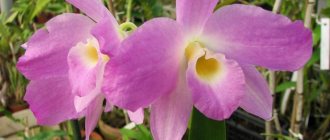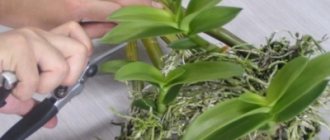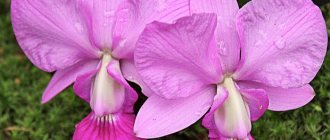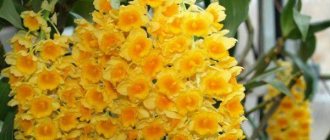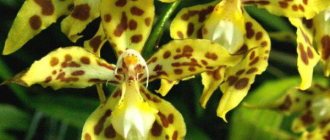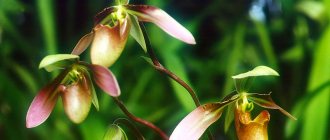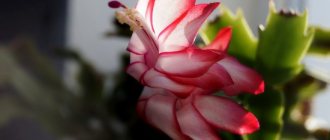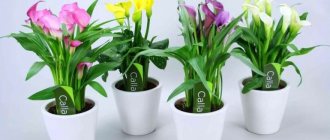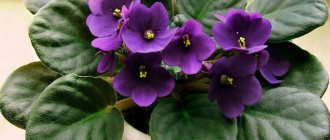Dendrobium is an unpretentious, beautifully flowering orchid. An epiphytic species with lanceolate leaves and large, showy flowers of a wide variety of colors.
Despite the wide variety of species, they all have one thing in common - the tube-shaped base of the flowers. Depending on the type, the height of the plant can vary from 20-30 cm to 1 meter. The dendrobium orchid is native to the tropical rainforests of Thailand, Malaysia and Sri Lanka.
Also see how to grow orchids such as vanda and paphiopedilum.
| The growth rate is high. Every year a new pseudobulb grows up to 70 cm. |
| Blooms in summer with proper care. |
| The plant is easy to grow. One of the easiest orchids to grow. |
| It is a perennial plant. |
Dendrobium: care at home. Briefly
Dendrobium orchid at home requires strict adherence to the rules of care:
| Temperature | In summer 15-30°, in winter 15-20°. |
| Air humidity | The creation of special conditions does not require. |
| Lighting | Requires a lot of bright, sunlight. |
| Watering | A special, loose substrate for orchids based on bark. |
| Soil for dendrobium orchids | Light, permeable and nutritious soil. |
| Feeding and fertilizer | During the period of intensive growth, use special fertilizers for orchids. |
| Orchid transplant | As it grows, in the spring. |
| Dendrobium propagation | Dividing overgrown plants. Cuttings and children. |
| Features of growing orchids | To set flower buds, a difference between day and night temperatures is required. |
How to choose a plant in a store?
When purchasing a dendrobium orchid, you should pay attention to the appearance of the plant and the presence of pests. The leaves of the plant should be green, bold and clean.
After delivering the orchid home, you should not rush with watering and replanting, you must:
- During the first month, isolate the flower from other house plants in a well-ventilated place.
- At first, you should not fertilize or replant.
- The first watering at home is carried out a week after purchase.
- If pests are detected, treat the plant with insecticides.
Caring for dendrobium at home. Details
Caring for a dendrobium orchid at home cannot be called difficult, but it still has a number of features.
Dendrobium orchid blooming
Dendrobium blooms after a short period of dormancy. Peduncles appear only on 2-3 year old bulbs. The total duration of the flowering period is 2-3 weeks.
The number of flowers directly depends on the temperature and light intensity during the dormant period. After flowering, old bulbs are not cut off. They should dry naturally. In this case, the nutrients accumulated in them will be absorbed by the remaining shoots.
New varieties of dendrobiums can bloom without a dormant period. The process of ripening and formation of bulbs continues in winter. The main thing is to provide the plant with the necessary lighting.
Temperature
The homemade dendrobium orchid develops well at normal room temperature. At the same time, it is desirable for her to ensure a difference between day and night temperatures. Lower temperatures at night promote the ripening of shoots and the formation of flower buds.
Spraying
All modern varieties of dendrobiums are perfectly adapted to the usual level of humidity in residential premises. Therefore, as a rule, they do not require spraying.
Lighting
The dendrobium orchid plant at home requires intense lighting. Varieties with dark-colored flowers are especially demanding in terms of light levels. In autumn and winter, southern windows are best suited for dendrobium.
In the summer, the plant must be moved to the east or west side.
Watering dendrobium orchids
Watering of dendrobium is carried out using the immersion method.
To do this, place the pot in a cup of warm water for 15-20 minutes. Irrigation water must be settled or filtered before use. Once a month, watering is replaced with a warm shower. The frequency of watering depends on the ambient temperature. In summer the plant is watered much more often, in winter very rarely. If the orchid is kept in the cold, watering is stopped completely. In case of severe wrinkling of the bulbs, simply spray it with warm water. In general, the substrate in the pot should dry completely between waterings.
Dendrobium orchid pot
For young orchids, choose small transparent pots made of plastic. To prevent the plants from turning over, several stones are placed on the bottom. Heavy, ceramic flowerpots are suitable for planting large, heavily grown specimens.
Priming
Dendrobium orchid is grown at home on a substrate of bark and moss. The soil mixture is prepared at the rate of 1 part crushed moss to 1 part bark, plus a small amount of pieces of charcoal and peat. Before planting, the substrate must be spilled with boiling water.
Feeding and fertilizer
To feed dendrobium, use special fertilizers for orchids. They are applied in the form of solutions every 3 or 4 waterings. If necessary, foliar sprays can also be used. During the dormant period, fertilizers are not used.
Transplanting a dendrobium orchid
Dendrobium orchid transplantation is carried out after the flower stalks dry out at the moment when the plant begins to grow intensively.
The need for transplantation is determined by the condition of the substrate. If it has decomposed, become salty, or mold has appeared on its surface, the plant must be replanted. During transplantation, pay attention to the condition of the root system. All rotten and blackened areas of roots must be cut back to healthy tissue. The resulting cut areas must be sprinkled with charcoal powder or cinnamon. In some cases, the plant may even need a smaller pot after root treatment.
After transplantation, the plant is not watered for a week.
Trimming
Dendrobium does not need special pruning. If necessary, completely dried stems and leaves are removed from the plant.
Rest period
For the mass formation of flower buds, the plant needs a period of rest. To do this, after growth has finished, the dendrobium is transferred to dry conditions at night temperatures no higher than +15-18°. In this case, the plant must be well lit. In such conditions, the flower is kept for at least 1.5 months.
During this period, the dendrobium is not watered. To prevent the bulbs from wrinkling, the shoots are sprayed with cool, pre-settled water 1-2 times a week.
Fertilizer
During the period of active growth and development, dendrobium especially actively needs feeding. Fertilizers should be divided into groups according to the content of useful substances. Until July, fertilizers containing nitrogen are applied, in the fall - phosphorus mixed with a low potassium content. During the dormant period, the orchid should not be fed, but only maintained with the optimal amount of light. If you fertilize your orchid with complex fertilizers, use only half the norm.
Evergreen and deciduous dendrobium orchids are fertilized differently. Deciduous orchids in the winter season are fertilized no more than twice a month with nitrogen fertilizers, while evergreen dendrobiums require phosphorus-potassium fertilizers.
Propagation of dendrobium orchid by dividing the bush
When transplanted, strongly overgrown dendrobium specimens can be divided into several parts. Each of them must have at least 3 well-developed, healthy bulbs. In some cases, it is allowed to leave a smaller number of shoots. But such plants, as a rule, take much longer to take root.
The sections formed after division must be dried and treated with charcoal powder or a weak solution of brilliant green. The cuttings are planted in a substrate for adult plants. During the first week they are only sprayed. In the future, they are watered little by little and very carefully. The usual watering regime is resumed only when the plants begin to grow.
After 2-3 weeks from planting, they can be fed with special fertilizer for orchids.
Propagation of dendrobium orchid by cuttings
At home, cuttings can be used for propagation. They are cut from shoots that have ripened but have never bloomed. Faded pseudobulbs with dormant buds remaining on them are also suitable for propagation. If the shoot is too long, it is cut into several parts about 10 cm long. All resulting sections must be processed. If the shoot is short, it is used entirely.
For rooting, prepare bags with wet moss. Prepared cuttings are placed in them. After this, the packages are hung in a well-lit, warm place. After a few weeks, babies begin to develop on the pseudobulbs. As soon as the young plants form root primordia, they are carefully separated.
For planting children, small greenhouses with substrate for adult plants are used. High humidity promotes accelerated root development. The disadvantage of this method of propagation is that plants obtained in this way will bloom no earlier than after 3-4 years.
Correct selection of soil
The peculiarity of the dendrobium orchid is that it does not live on the ground, but exists. Attached to the trunks, roots and branches of trees.
The easiest way is to buy land in a store. You can prepare the soil yourself . To do this, it is necessary to displace the bark of coniferous trees, fine expanded clay, crushed moss, coconut fibers, charcoal and fine peat. If the substrate is prepared independently, it must be disinfected. Or boil over heat for about 3-4 minutes. Or pour boiling water for 10 minutes. The water must then be drained. And dry the ground.
Reproduction of dendrobium orchids by children
Babies are periodically formed on the pseudobulbs of dendrobium. They can be used for reproduction. The children are separated after the rudiments of roots develop on them. On average, this takes about a year. Using a sharp knife, they are cut off with a small piece of the mother stem or separated with a twisting motion. The resulting sections must be dried for several hours and then treated with a solution of brilliant green.
Children with well-developed roots are planted in small pots with a regular substrate for dendrobiums. The first few days they are not watered, but only sprayed. In the future, they do not need to create any special conditions; ordinary care is quite enough. Such plants, if grown correctly, can bloom as early as next year.
Diseases and pests
Due to errors in care, an orchid can suffer from a number of diseases:
- Dendrobium does not bloom. Lack of flowering is most often due to insufficient lighting or lack of a dormant period. To correct the situation, the plant must be moved to a brighter place and ensure the correct temperature conditions.
- The roots rot. Most often it is a consequence of excessive watering. The substrate should dry out between waterings.
- Dendrobium leaves have lost turgor and become lethargic. The plant most likely suffers from lack of moisture and high temperature. In hot weather, the orchid should be watered without waiting for the substrate to dry completely.
- Dendrobium leaves turn yellow. The reason may lie in an excess of fertilizers. When applying fertilizing, it is necessary to strictly follow the recommended norms.
- The leaves are pale and light. The plant lacks calcium and magnesium. To eliminate the deficiency, it is recommended to apply appropriate fertilizers.
- Brown spots on dendrobium leaves. The plant has suffered from direct sunlight or too high a temperature. The orchid should be moved to partial shade or shaded from the sun.
- The tips of dendrobium leaves dry out. Most often, this phenomenon occurs when the air is too dry or if the plant pot is located next to a heating radiator.
The most common pests that attack dendrobium are spider mites, whiteflies, aphids, and scale insects. To combat them, it is necessary to use special insecticides.
Possible problems
The root system of dendrobium is very fragile, so it is easily susceptible to pests . When planting, you must carefully examine the roots for diseases and pests.
Important : Every time you transplant, you must take all necessary measures to prevent infection of the weakened root. Treat tools, pot, disinfect substrate.
The leaves of the dendrobium orchid are worth observing . If the leaves are green, then the growing conditions are comfortable. If they “turn pale”, it is necessary to move it to another place, perhaps the light is too bright for it, and burns may even appear on the leaves. If the leaves become dark or yellow, you should definitely add lighting.
Types of orchid dendrobium domestica with photos and names
In indoor floriculture, the following types are most widespread:
Dendrobium nobile
Large epiphytic species. It is characterized by dense, articulated stems with constrictions in the area of internodes up to 70 cm high. The leaf blades are arranged in two rows. The total lifespan of the stems does not exceed 2 years. Peduncles are short, appearing on last year's shoots. Consist of 2-4 brightly colored flowers with a characteristic turned-down lip.
Dendrobium phalaenopsis
A large species with lanceolate leaves located at the top of the fleshy shoots. The peduncle is curved, up to 60 cm long. The flowers are collected in large, drooping racemes. Their color varies from soft pink to deep crimson. In this case, the lip is always colored more intensely. With good care, the flowering period can last up to six months. The species is grown as an industrial crop to obtain high-quality cuttings.
Dendrobium densiflorum
A species with tetrahedral stems covered with membranous sheaths. The top of the shoots is crowned with 3-4 lanceolate leaves. The inflorescences consist of many flowers collected in large drooping racemes. The length of the brushes can reach up to 30 cm with the number of colors exceeding 50 pieces. The flowers are about 5 cm in diameter, bright yellow in color with an orange stripe along the edge of the lip.
Dendrobium hybrids bred on the basis of the species described above are also widespread in indoor culture:
Dendrobium Stardust
Prized for its original red-orange color with brown streaks.
Dendrobium Dorrigo 'Wisteria'
It has interesting stems that resemble reeds.
Dendrobium Formidable
It was obtained by crossing D. formnsum and D. infundibulum.
Dendrobium Red Fair 'Akebono'
A brightly colored hybrid with a contrasting lip.
Botanical description
The unsurpassed beauty of Dendrobium nobile
nobile leads an epiphytic lifestyle and grows at an altitude of 1800 m above sea level in the Indian state of Sikiim.
Dendrobium is a sympodial orchid. This means that after the mother plant dies, daughter shoots appear in its place. They are the ones who continue the life of the plant.
The roots are hard and white. At the base of the straight stem there are cylindrical pseudobulbs. The alternate arrangement of lanceolate or linear leaves is characteristic.
Flower buds are located in the axils of the leaves. The life of each shoot is short - only 2-3 years. Then death occurs.
Fragrant snow-white, lilac, orange, red, yellow flowers densely cover long shoots. Thanks to breeding work, hybrid varieties with three-color colors have been developed.
Dendrobium noble is a bestseller. Before it goes on the store shelf, it is grown using stimulants. Therefore, after purchase, it can also bloom beautifully several more times. Then you will have to organize proper care for it in order to enjoy its flowering.
